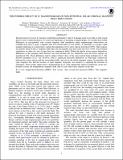Files in this item
The possible impact of L5 magnetograms on non-potential solar coronal magnetic field simulations
Item metadata
| dc.contributor.author | Weinzierl, Marion | |
| dc.contributor.author | Mackay, Duncan Hendry | |
| dc.contributor.author | Yeates, Anthony Robinson | |
| dc.contributor.author | Pevtsov, Alexei | |
| dc.date.accessioned | 2016-09-12T12:30:12Z | |
| dc.date.available | 2016-09-12T12:30:12Z | |
| dc.date.issued | 2016-09-10 | |
| dc.identifier | 244378161 | |
| dc.identifier | 4e213501-172f-483f-954a-669629e64797 | |
| dc.identifier | 84991649510 | |
| dc.identifier | 000384101600001 | |
| dc.identifier.citation | Weinzierl , M , Mackay , D H , Yeates , A R & Pevtsov , A 2016 , ' The possible impact of L5 magnetograms on non-potential solar coronal magnetic field simulations ' , Astrophysical Journal , vol. 828 , no. 2 , 102 . https://doi.org/10.3847/0004-637X/828/2/102 | en |
| dc.identifier.issn | 0004-637X | |
| dc.identifier.other | ORCID: /0000-0001-6065-8531/work/58055420 | |
| dc.identifier.uri | https://hdl.handle.net/10023/9480 | |
| dc.description.abstract | The proposed Carrington-L5 mission would bring instruments to the L5 Lagrange point to provide us with crucial data for space weather prediction. To assess the importance of including a magnetograph, we consider the possible differences in non-potential solar coronal magnetic field simulations when magnetograph observations are available from the L5 point, compared to an L1-based field of view. A time series of synoptic radial magnetic field maps is constructed to capture the emergence of two active regions from the L5 field of view. These regions are initially absent in the L1 magnetic field maps, but are included once they rotate into the L1 field of view. Non-potential simulations for the two sets of input data are compared in detail. Within the bipolar active regions themselves, differences in the magnetic field structure can exist between the two simulations once the active regions are included in both. These differences tend to reduce within 5 days of the active region being included in L1. The delayed emergence in L1 can however lead to significant persistent differences in long range connectivity between the active regions and the surrounding fields, and also in the global magnetic energy. In particular, the open magnetic flux, and the location of open magnetic foot points, are sensitive to capturing the real time of emergence. These results suggest that a magnetograph at L5 could significantly improve predictions of the non-potential corona, interplanetary magnetic field and of solar wind source regions on the Sun. | |
| dc.format.extent | 12 | |
| dc.format.extent | 4672376 | |
| dc.language.iso | eng | |
| dc.relation.ispartof | Astrophysical Journal | en |
| dc.subject | Magnetohydrodynamics (MHD) | en |
| dc.subject | Sun: corona | en |
| dc.subject | Sun: coronal mass ejections (CMEs) | en |
| dc.subject | Sun: magnetic fields | en |
| dc.subject | QB Astronomy | en |
| dc.subject | QC Physics | en |
| dc.subject | 3rd-DAS | en |
| dc.subject.lcc | QB | en |
| dc.subject.lcc | QC | en |
| dc.title | The possible impact of L5 magnetograms on non-potential solar coronal magnetic field simulations | en |
| dc.type | Journal article | en |
| dc.contributor.sponsor | The Leverhulme Trust | en |
| dc.contributor.sponsor | Science & Technology Facilities Council | en |
| dc.contributor.sponsor | Science & Technology Facilities Council | en |
| dc.contributor.sponsor | EPSRC | en |
| dc.contributor.institution | University of St Andrews. Applied Mathematics | en |
| dc.identifier.doi | 10.3847/0004-637X/828/2/102 | |
| dc.description.status | Peer reviewed | en |
| dc.identifier.grantnumber | RPG-305 | en |
| dc.identifier.grantnumber | ST/K000950/1 | en |
| dc.identifier.grantnumber | ST/N000609/1 | en |
| dc.identifier.grantnumber | N/A | en |
This item appears in the following Collection(s)
Items in the St Andrews Research Repository are protected by copyright, with all rights reserved, unless otherwise indicated.

